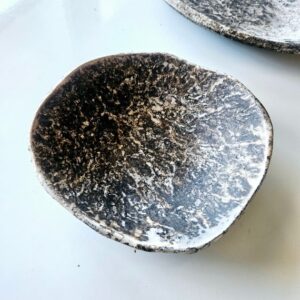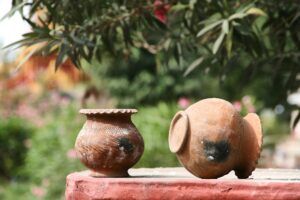The guide “How to fire ceramics with oil spot tenmoku glazes for best results” offers detailed steps for achieving optimal outcomes when firing ceramics with these unique glazes. By following the instructions carefully, you can create stunning pieces with captivating oil spot effects. And here’s a crazy fact: Did you know that oil spot tenmoku glazes originated in ancient China over a thousand years ago and were highly prized for their beauty and depth of color?
Glazing Techniques with Oil Spot
Prepare the Ceramics
Clean and dry the ceramics thoroughly before applying the oil spot tenmoku glaze. Start by wiping the surface of the ceramics with a damp cloth to remove any dust or debris. Ensure that all areas are well-cleaned, paying special attention to corners and edges where dirt can accumulate. Next, let the ceramics air dry completely or use a clean, dry cloth to wipe them down. It is crucial that the ceramics are entirely dry before proceeding to apply the glaze, as moisture can affect the application and final result. By following these steps, you will create a smooth, even surface for the oil spot tenmoku glaze to adhere to, ensuring a successful and beautiful finish.
Apply the Glaze
Using a brush or dipping method, apply a consistent layer of oil spot tenmoku glaze to the ceramics. Ensure that the glaze is evenly spread to avoid any patchy areas. Allow the glaze to dry completely before proceeding with any additional steps. Check for any drips or excess glaze that might affect the final appearance of the ceramics and remove them carefully. It is essential to apply the glaze with precision to achieve a smooth and professional finish.
Load the Kiln
Place the glazed ceramics carefully in the kiln, ensuring proper spacing between items for even heat distribution during firing. Arrange the ceramics in a single layer on the kiln shelf, making sure they do not touch each other. For example, if you are firing multiple mugs, leave at least an inch of space between each one. This will allow the heat to circulate evenly around each piece, resulting in a more uniform firing.
Avoid stacking or overcrowding the ceramics in the kiln, as this can lead to uneven heating and potential damage. Remember to also leave some space between the ceramics and the walls of the kiln to ensure proper airflow. By taking the time to place the glazed ceramics with care and attention to spacing, you can help ensure a successful firing process and achieve consistent results in your final pieces.
Fire the Ceramics
- Follow the recommended firing schedule for oil spot tenmoku glazes.
- Monitor the kiln temperature to achieve the desired effect.
- Preheat the kiln to the recommended temperature gradually.
- Place the ceramics loaded with the oil spot tenmoku glazes carefully inside the kiln.
- Start the firing process according to the specified schedule.
- Regularly check the kiln temperature to ensure it aligns with the guidelines for the oil spot tenmoku glazes.
- Adjust the heat settings if needed to achieve the desired finish on the ceramics.
- Once the firing is complete, allow the kiln to cool down slowly before opening it to avoid any cracks or damage to the ceramics.
Cool Down
After firing, allow the ceramics to cool down slowly in the kiln to prevent thermal shock and preserve the glaze’s appearance. Switch off the kiln but keep the ceramics inside. Avoid opening the kiln door immediately; let the temperature drop gradually. Wait until the kiln reaches room temperature before removing the ceramics. Gently place the ceramics on a heat-resistant surface to cool completely. Handle the cooled ceramics with care to avoid any damage. Avoid sudden temperature changes to prevent cracking or damage to the glaze.
Final Touches
Inspect the cooled ceramics closely for imperfections or areas requiring touch-ups. Examine the surface for cracks, uneven glazing, or chips. If you find any, carefully smooth out rough edges or fill in cracks with ceramic putty. Wipe down the pieces with a damp cloth to remove any dust or debris. Use a soft brush to gently clean intricate details. Avoid using harsh chemicals that could damage the finish.
After cleaning, allow the ceramics to dry completely before proceeding. Evaluate the pieces again to ensure they are free of any dirt or residue. Feel the surface for any remaining rough spots or blemishes that may need further attention. Apply additional glaze or paint as needed, using a steady hand to match the existing finish. Let the touch-ups dry completely before handling the ceramics again.
Optimal Firing Techniques Summary
In conclusion, adhering to the outlined steps will enable you to successfully fire ceramics with oil spot tenmoku glazes, ensuring optimal results.
Materials Needed
Firing Techniques Revealed
Application Techniques for Achieving the Perfect Oil Spot Tenmoku Effect
- Start with a clean and dry ceramic or pottery piece
- Apply the oil spot tenmoku glaze evenly using a brush or dipping method
- Allow the glaze to dry completely before firing in a kiln
- Fire the piece according to the specific firing instructions for the oil spot tenmoku glaze
- After firing, carefully inspect the piece for the desired oil spot effect and adjust technique for future projects if needed
Oil Spot Tenmoku FAQ
Yes, there can be variations in color that can be achieved with oil spot tenmoku glazes. While traditional tenmoku glazes are known for producing dark brown to black colors with interesting oil spot patterns, variations can occur due to factors such as the specific ingredients used, firing temperature, and the amount of oxygen present during the firing process. This can result in colors ranging from deep reds and purples to metallic greens and blues in oil spot tenmoku glazes.
The distinctive oil spot effect in oil spot tenmoku glazes is caused by the interaction of iron oxide particles in the glaze with the reduction firing atmosphere. During the firing process, the iron in the glaze migrates to the surface due to the reduction firing conditions, creating the characteristic oil spot patterns as the glaze cools. The size and distribution of the oil spots can vary based on factors like temperature, firing time, and the composition of the glaze.
Oil spot tenmoku glazes typically contain raw materials such as iron oxide, manganese dioxide, and high amounts of carbon. These materials are crucial in creating the characteristic oil spot effect seen in tenmoku glazes.
The surface tension of the glaze can affect the formation of oil spots in a few ways. Lower surface tension can make it easier for oil to spread out instead of beading up, which can lead to more uniform and larger oil spots. Higher surface tension can cause the oil to bead up and form smaller, more distinct oil spots. Additionally, surface tension can impact how the oil interacts with the glaze surface, affecting the final appearance and texture of the oil spots.
Oil spot tenmoku is a type of glaze commonly used in pottery and ceramics. It is known for its distinctive appearance, characterized by dark, glossy surfaces with metallic oil-like spots that seem to float on the glaze. This effect is achieved through a specific firing process where the glaze is allowed to flow and create these unique patterns. Oil spot tenmoku glazes are highly prized for their beauty and are often used to create elegant and sophisticated pieces of ceramic art.
Oil spot tenmoku glazes are typically fired at a temperature range of Cone 9 to Cone 10, which corresponds to approximately 2300 to 2350 degrees Fahrenheit (1260 to 1290 degrees Celsius).
Oil spot tenmoku glazes and traditional tenmoku glazes are both types of glazes used in pottery, but they have distinct differences.
Oil spot tenmoku glazes are a type of tenmoku glaze that contains oil added during the firing process. This oil creates a unique effect where small craters or “oil spots” appear on the glazed surface, giving it a distinctive and visually striking appearance.
Traditional tenmoku glazes, on the other hand, do not involve the addition of oil during firing. These glazes are typically high in iron oxide and have a very dark, almost black color with a glossy finish. Traditional tenmoku glazes are known for their rich and lustrous appearance, often with a characteristic “hare’s fur” or “oil spot” effect caused by the unique way they interact with the kiln atmosphere during firing.
In summary, the main difference between oil spot tenmoku and traditional tenmoku glazes lies in the addition of oil during firing and the resulting visual effects on the glazed surface.
The thickness of the glaze application can affect the appearance of oil spots in oil spot tenmoku glazes. A thicker glaze application tends to result in larger and more prominent oil spots, as the glaze will pool and create more dramatic variations in thickness. Conversely, a thinner glaze application may lead to smaller and more subtle oil spots. The degree of control over the size and distribution of oil spots in the final glaze can be influenced by the thickness of the glaze applied.
Oil spot tenmoku glazes are known for their lustrous black appearance with distinctive oil-spot-like patterns that resemble small bursts of iridescent oil. These glazes typically have a glossy finish and display a range of colors, including metallic hues such as gold, bronze, and copper. The oil spot effect is achieved through controlled crystallization during the cooling process, resulting in the unique patterns that make this type of tenmoku glaze highly sought after in ceramics.








I encountered some bubbling in the glaze during firing despite following the guide carefully. Any tips on how to prevent this issue in the future?
I’m sorry to hear about the bubbling issue you faced. Bubbling can sometimes occur due to trapped air or impurities in the glaze. Make sure to thoroughly mix the glaze and apply it smoothly to help reduce bubbling. It’s also helpful to bisque fire your ceramics properly before applying the glaze to minimize potential issues.
After following this guide step by step, I successfully fired ceramics with oil spot tenmoku glazes for the first time. The results were stunning – rich, deep colors with beautiful oil spot patterns. Thank you for such clear instructions!
That’s awesome to hear! So glad the guide helped you achieve those stunning oil spot tenmoku glazes. Enjoy those rich, deep colors and beautiful patterns. Happy firing and keep creating those ceramic masterpieces! 🔥🎨
Thank you for sharing your experience with glaze thickness variations! It’s interesting to hear how it can impact the final results. Different thicknesses can indeed create various effects, so experimenting with this aspect is a great idea.
You’re welcome! Glaze thickness can definitely make a big difference in the final look. It’s like a little adventure—each variation can lead to unique and beautiful effects. Happy experimenting and may your ceramics always surprise you! 🎨✨
I’ve found that varying the thickness of the oil spot tenmoku glaze application can lead to different effects. Experimenting with thinner or thicker layers might produce unique patterns during firing. Has anyone else tried this method?
That’s a great insight! Varying the thickness of the oil spot tenmoku glaze can definitely lead to different and unique patterns. Has anyone else experimented with thinner or thicker layers? I’d love to hear about your results and see your beautiful creations!